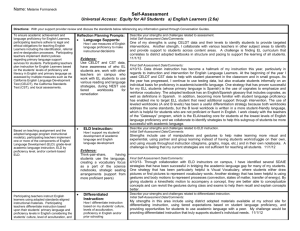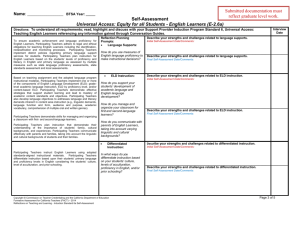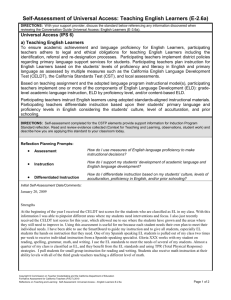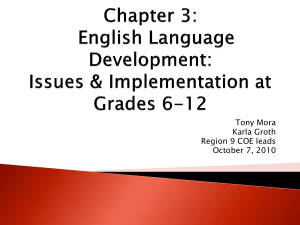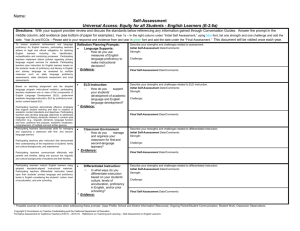ModuleEpage3
advertisement
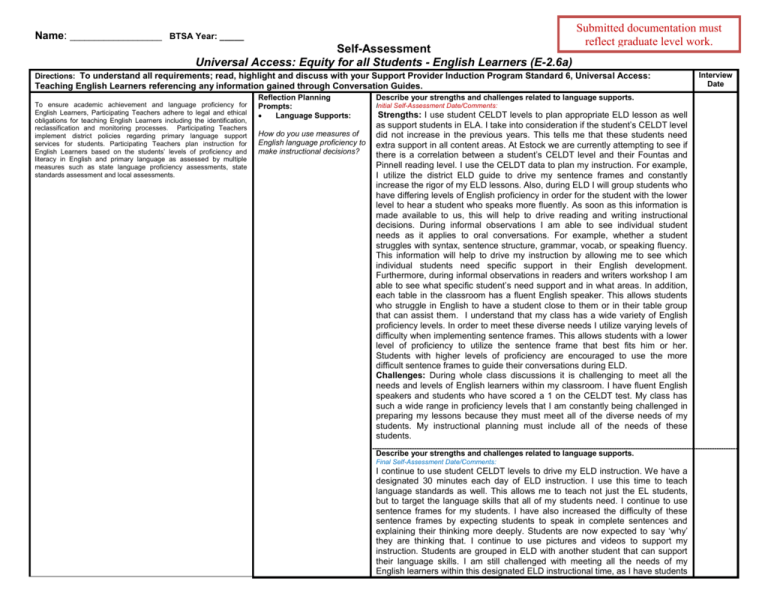
Name: ___________________ BTSA Year: _____ Self-Assessment Universal Access: Equity for all Students - English Learners (E-2.6a) Submitted documentation must reflect graduate level work. graduate level work. Directions: To understand all requirements; read, highlight and discuss with your Support Provider Induction Program Standard 6, Universal Access: Teaching English Learners referencing any information gained through Conversation Guides. To ensure academic achievement and language proficiency for English Learners, Participating Teachers adhere to legal and ethical obligations for teaching English Learners including the identification, reclassification and monitoring processes. Participating Teachers implement district policies regarding primary language support services for students. Participating Teachers plan instruction for English Learners based on the students’ levels of proficiency and literacy in English and primary language as assessed by multiple measures such as state language proficiency assessments, state standards assessment and local assessments. Reflection Planning Prompts: Language Supports: How do you use measures of English language proficiency to make instructional decisions? Describe your strengths and challenges related to language supports. Initial Self-Assessment Date/Comments: Strengths: I use student CELDT levels to plan appropriate ELD lesson as well as support students in ELA. I take into consideration if the student’s CELDT level did not increase in the previous years. This tells me that these students need extra support in all content areas. At Estock we are currently attempting to see if there is a correlation between a student’s CELDT level and their Fountas and Pinnell reading level. I use the CELDT data to plan my instruction. For example, I utilize the district ELD guide to drive my sentence frames and constantly increase the rigor of my ELD lessons. Also, during ELD I will group students who have differing levels of English proficiency in order for the student with the lower level to hear a student who speaks more fluently. As soon as this information is made available to us, this will help to drive reading and writing instructional decisions. During informal observations I am able to see individual student needs as it applies to oral conversations. For example, whether a student struggles with syntax, sentence structure, grammar, vocab, or speaking fluency. This information will help to drive my instruction by allowing me to see which individual students need specific support in their English development. Furthermore, during informal observations in readers and writers workshop I am able to see what specific student’s need support and in what areas. In addition, each table in the classroom has a fluent English speaker. This allows students who struggle in English to have a student close to them or in their table group that can assist them. I understand that my class has a wide variety of English proficiency levels. In order to meet these diverse needs I utilize varying levels of difficulty when implementing sentence frames. This allows students with a lower level of proficiency to utilize the sentence frame that best fits him or her. Students with higher levels of proficiency are encouraged to use the more difficult sentence frames to guide their conversations during ELD. Challenges: During whole class discussions it is challenging to meet all the needs and levels of English learners within my classroom. I have fluent English speakers and students who have scored a 1 on the CELDT test. My class has such a wide range in proficiency levels that I am constantly being challenged in preparing my lessons because they must meet all of the diverse needs of my students. My instructional planning must include all of the needs of these students. Describe your strengths and challenges related to language supports. Final Self-Assessment Date/Comments: I continue to use student CELDT levels to drive my ELD instruction. We have a designated 30 minutes each day of ELD instruction. I use this time to teach language standards as well. This allows me to teach not just the EL students, but to target the language skills that all of my students need. I continue to use sentence frames for my students. I have also increased the difficulty of these sentence frames by expecting students to speak in complete sentences and explaining their thinking more deeply. Students are now expected to say ‘why’ they are thinking that. I continue to use pictures and videos to support my instruction. Students are grouped in ELD with another student that can support their language skills. I am still challenged with meeting all the needs of my English learners within this designated ELD instructional time, as I have students Interview Date who have scored from a 1 to a 5 on the CELDT test. Based on teaching assignment and the adopted language program instructional model(s), Participating Teachers implement one or more of the components of English Language Development (ELD): gradelevel academic language instruction, ELD by proficiency level, and/or content-based ELD. Participating Teachers demonstrate effective strategies that support student learning and lead to mastery of academic content standards and objectives. Participating Teachers also develop language objectives to addresses language and literacy demands inherent in content area instruction (e.g., linguistic demands, language function and form, audience and purpose, academic vocabulary, comprehension of multiple oral and written genres). Participating Teachers demonstrate skills for managing and organizing a classroom with first- and second-language learners. Participating Teachers plan instruction that demonstrate their understanding of the importance of students’ family, cultural backgrounds, and experiences. Participating Teachers communicate effectively with parents and families, taking into account the linguistic and cultural backgrounds of students and their families. ELD Instruction: Describe your strengths and challenges related to ELD instruction. Initial Self-Assessment Date/Comments: How do you support your students’ development of academic language and English language development? How do you manage and organize your classroom for first and second-language learners? How do you communicate with parents of English Learners, taking into account varying linguistic and cultural backgrounds? Strengths: Within our daily schedule we are required to have 30 minutes dedicated strictly to English Language Development. The first 30 minutes of our day begins with ELD. During this time students are practicing their oral language skills. On my powerpoint presentation I place a real life picture. We use this picture to drive our conversations. Students’ oral language skills are supported by the use of thinking stems. Students use the thinking stems to describe to their partner what is happening or what they are noticing in the picture. I utilize varying levels of difficulty with the thinking stems in order to meet the diverse needs of my students. The thinking stems used in ELD are a foundation for other content areas. We use thinking stems in reading, writing, word work and science. I implement the practices used in ELD instruction across all content areas. This allows me to introduce different types of academic language as it applies to the content area. Students are then able to apply that academic language throughout different content areas. At each table I have strategically placed a fluent English speaker to assist non proficient speakers in group work. One of our main focuses throughout all content areas is to read and write in complete sentences. Whenever I hear a student speaking not in a complete sentence I correct them, and have them repeat it in a complete sentence. Furthermore, if I hear a student respond using incorrect syntax or grammar I always make a point to politely correct them and have them repeat it correctly. I manage and organize my classroom for first and second-language learners by having students repeat my directions orally. This ensures that every student, no matter their proficiency level, are able to understand the specified direction. To support second-language learners I utilize pictures/icons that are associated with academic vocabulary and concepts we are learning. I front load vocabulary for students in all content areas. I also activate prior knowledge before beginning a new lesson. In addition, to support both first and second-language learners I relate what we are talking about to real life situations that the students can relate to. I communicate with parents of English learners by thoroughly explaining what the CELDT test means and how it affects their child. I utilize our community liaison and AmeriCorp volunteer to help translate any conversations into Spanish. I make sure all documents that are sent home are translated into Spanish for all my parents to be able to read. Challenges: It is challenging to communicate with parents when I do not speak Spanish. Also, it is challenging to know how to best support my students given all their specific differences and needs in English language development. It can be challenging to find resources for planning and implementing meaningful ELD lessons. In addition, it is challenging to find enough time to plan purposeful instruction that meets all of the proficiency needs of my students, as well as finding enough time in our day to implement these lessons. Describe your strengths and challenges related to ELD instruction. Final Self-Assessment Date/Comments: I continue to use sentence frames and thinking stems throughout all academic content areas. This has been extremely helpful for my EL students. In the beginning of the year I was having students repeat my directions orally. I no longer have to do this as my students have made such tremendous progress in understanding my directions and expectations. I continue to use pictures and videos to support academic vocabulary and learning concepts. I have formed a strong relationship with our community liaison, as she helps me to communicate with a lot of the parents in my classroom. It is still challenging to find strategic and productive resources to drive ELD instruction. Although the implementation of the language standards in ELD instruction has supplemented the lessons, it is still hard to make sure the needs of all EL students are being met. Participating Teachers instruct English Learners using adopted standards-aligned instructional materials. Participating Teachers differentiate instruction based upon their students’ primary language and proficiency levels in English considering the students’ culture, level of acculturation, and prior schooling. Differentiated Instruction: In what ways do you differentiate instruction based on your students’ culture, levels of acculturation, proficiency in English, and/or prior schooling? Describe your strengths and challenges related to differentiated instruction. Initial Self-Assessment Date/Comments: Strengths: In the beginning of the school year I always make sure that I check my student’s cums. This information is very helpful in that I am able to see where they went to school before this year, what grades they received, and if they had been SST’d in the past. Tapping into my student’s prior schooling through looking at each student’s cum helps me to understand where the student came from academically and behaviorally. I differentiate instruction based on this information, especially in the first several months of school. Understanding how a student performed in prior years helps drive my small group and partner work throughout all content areas. I also differentiate instruction by utilizing students Dibels and running record scores. This information drives our partner and small group work. For my students who have scored low in Dibels and running records they receive extra small group, guided reading assistance during reader’s workshop. I differentiate my instruction for differing levels of English proficiency by providing sentence frames in every content area. I provide a wide variety of sentence frames that will assist all proficiency levels. This allows my less proficient students to fully understand the concepts. Furthermore, at each table group I have placed an English proficient student that can assist less proficient students with collaborative group work. I differentiate instruction based on a student’s culture by understanding each child’s cultural background. Through researching the Aeries portal I am able to have a glimpse into each student’s cultural and familial background. For example, there are many students in my class who only speak Spanish at home. I differentiate my instruction for these students by front loading vocabulary, especially academic vocabulary. I also brainstorm with students to help activate their prior knowledge and make it easier for them to generate their thoughts in English. I also scaffold information and explicitly model tasks for less proficient English speakers. Finally, through the interactive read aloud and mentor texts I use for readers and writers workshop I make sure that I differentiate between the cultures that are being represented. I understand that although most students come from a Hispanic background, not all of them do. I find it very powerful to introduce different cultures, even ones not represented within my classroom, to my students. This allows students to understand how similar they are with their classmates and people in their community. Challenges: Although all of my students were born in the United States they have varying levels of acculturation. Depending on when their parents and families came to America can make it challenging to differentiate my instruction. I take into consideration the varying levels, but it is challenging to know and understand which families and students need more support. I attempt to get to know each child and their families through parent conferences and informal conversations. This helps me to understand which students receive more support at home and which ones need more differentiation within the classroom. It is also challenging to fully understand the level of academic instruction that a student received in prior years of schooling. Prior grades and teacher notes help, but it is challenging to fill in instructional gaps when a lot of my students have moved schools and school districts so many times in their lives. I am unsure what type of academic and behavioral foundation they have and how I can support them and build upon it. Describe your strengths and challenges related to differentiated instruction. Final Self-Assessment Date/Comments: I continue to differentiate instruction throughout the day in many ways. I differentiate reading instruction based on individual conferencing and reading levels. I differentiate writing instruction by pulling a small group of struggling students. I partner non EL and El students together in order to help each other. My students have also grown to love learning about different cultures and parts of the world through interactive read alouds, mentor texts and shared readings. This has opened my students’ eyes to different parts of the world, not just what is here in California. I am still consistently front loading vocabulary, brainstorming with students, and explicitly modeling lessons before students work independently. It is still challenging to fully understand the level of academic instruction that a student received in prior years of schooling. Our students tend to move a lot, and it is hard to really understand what they have learned in years prior. Copyright © Commission on Teacher Credentialing and the California Department of Education Formative Assessment for California Teachers (FACT) – 2014 Reflections on Teaching and Learning - Induction Standard 6a Self-Assessment Page 3 of 5
